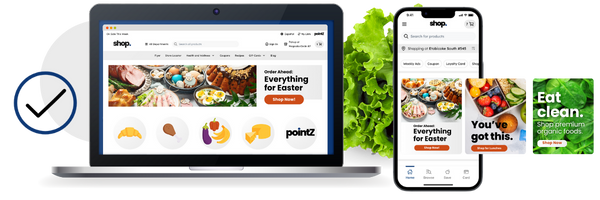Customer loyalty programs support and maintain strong relationships between businesses and their customers. These programs are designed to encourage repeat purchases, improve customer retention, and strengthen brand loyalty. By offering rewards, discounts, or exclusive benefits, businesses create an emotional connection with their customers, making them more likely to return.
Successful loyalty programs go beyond simple discounts. They offer structured reward programs that provide real value, such as points-based rewards, tiered benefits, and exclusive loyalty rewards. When businesses align these programs with customer expectations, they not only increase sales but also boost overall customer engagement.
Many brands are moving toward digital loyalty programs that integrate with mobile apps and online accounts. These systems offer seamless tracking, personalized incentives for customers, and real-time updates on rewards. Customers appreciate convenience, and businesses that embrace digital solutions gain a competitive edge in customer retention.
Implementing well-structured customer loyalty programs can significantly impact business success. Companies that focus on delivering membership benefits and valuable rewards see increased customer satisfaction, higher spending per visit, and long-term brand commitment.
The Importance of Customer Loyalty Programs in Grocery Retail
Customer loyalty programs are structured marketing strategies designed to encourage repeat business by offering rewards, discounts, or exclusive benefits. These programs strengthen brand loyalty by making customers feel valued and appreciated, creating an emotional bond with the store. In grocery retail, where competition is fierce and pricing often determines purchasing decisions, well-designed loyalty programs can differentiate a store from its competitors.
By implementing reward programs, grocery stores can influence shopping habits, ensuring that customers prefer their store over others. These programs typically offer points-based rewards, cash-back incentives, or personalized discounts that encourage frequent purchases. When customers see the value in their continued loyalty, they are more likely to return, increasing overall sales and lifetime customer value.
Why Independent Grocers Must Focus on Customer Loyalty and Retention
Independent grocery stores often struggle to compete with supermarket chains and e-commerce retailers. To remain competitive, they must prioritize customer loyalty and retention by offering personalized experiences that big retailers cannot match. Retaining existing customers is significantly more cost-effective than acquiring new ones, making loyalty-focused strategies a smart investment.
- Increases Repeat Business: Customers with rewards are more likely to choose the same store for their grocery needs.
- Differentiates from Large Retailers: Unique loyalty programs give independent grocers a competitive edge.
- Improves Customer Lifetime Value: Loyal shoppers spend more over time, contributing to long-term profitability.
- Encourages Word-of-mouth Marketing: Satisfied customers are more likely to refer friends and family, driving organic growth.
By focusing on personalized loyalty programs, independent grocers can build stronger relationships with their customers, ensuring repeat visits and consistent revenue growth.
How Loyalty Rewards and Incentives for Customers Enhance Long-Term Relationships
Shoppers are more likely to stay loyal when they feel they are getting value from a store. Loyalty rewards and incentives for customers create a sense of appreciation, encouraging long-term engagement. These incentives can take various forms, from instant discounts to tier-based rewards, each reinforcing the customer’s commitment to the brand.
- Points-Based Rewards: Customers earn points for every purchase, which can be redeemed for discounts or free products.
- Exclusive Membership Benefits: VIP members get access to special promotions, early-bird discounts, or premium services.
- Personalized Offers: Using purchase history, grocers can offer discounts on frequently bought items, increasing customer engagement.
- Seasonal and Limited-Time Promotions: Special deals during holidays or peak seasons encourage increased spending.
A well-structured customer loyalty program fosters trust, making shoppers feel appreciated and more likely to continue shopping at the same store. When customers see real value in their loyalty rewards, they develop lasting relationships with the brand, ensuring sustained business success.
Navigating Competitive Challenges: How Independent Grocers Can Retain Customers
Independent grocers operate in an increasingly competitive market where national chains and e-commerce giants dominate. These large retailers offer lower prices, wider product selections, and convenient shopping experiences, making it harder for smaller grocery stores to maintain customer loyalty. Additionally, the rise of online grocery shopping has further intensified the competition, forcing independent grocers to rethink their strategies for customer retention.
Challenges Independent Grocers Face Against Large Retailers

Despite the challenges, independent grocers can build strong customer loyalty by focusing on personalized experiences, digital convenience, and exclusive rewards. By leveraging digital loyalty programs and reward programs, they can increase customer engagement, ensuring that shoppers return regularly. Competing with large retailers requires a strategic approach, but with the right loyalty-driven initiatives, independent grocers can establish a loyal and profitable customer base.
- Price Competition: Large retailers benefit from bulk purchasing power, allowing them to offer lower prices.
- Convenience and Technology: Big chains provide online shopping, mobile apps, and self-checkout options that independent grocers often lack.
- Marketing Reach: Supermarkets have larger budgets for advertising, making it difficult for smaller stores to attract new customers.
- Customer Expectations: Shoppers demand personalized experiences, rewards, and seamless shopping, which can be difficult to implement without proper technology.
To compete effectively, independent grocers must leverage innovative loyalty programs that go beyond discounts, focusing on personalized engagement and customer experience.
The Role of Digital Loyalty Programs in Leveling the Playing Field
Digital loyalty programs provide independent grocers with an opportunity to compete with larger retailers by offering convenience, personalization, and exclusive benefits. These programs integrate with mobile apps, email marketing, and online shopping platforms, allowing small businesses to engage with customers beyond the physical store.
- Convenience for Customers: Mobile-based loyalty programs allow customers to track rewards, receive personalized deals, and redeem offers effortlessly.
- Real-Time Customer Engagement: Automated notifications about special promotions and discounts encourage repeat visits.
- Data-Driven Decision Making: Digital programs help grocers understand purchasing trends, enabling targeted promotions that enhance customer retention.
- Integration with Online Shopping: Offering digital rewards linked to e-commerce platforms allows independent grocers to provide a seamless omnichannel experience.
By adopting digital loyalty programs, independent grocers can offer the same level of convenience as large retailers while maintaining their unique, customer-focused approach.
Why Personalized Reward Programs Strengthen Customer Engagement
Generic discounts no longer appeal to modern consumers. Shoppers expect reward programs that cater to their buying habits, preferences, and shopping frequency. Personalized rewards create a stronger emotional connection, increasing customer engagement and repeat business.
- Customized Discounts: Offering deals based on past purchases makes customers feel valued and encourages continued spending.
- Exclusive Perks for Frequent Shoppers: Special membership benefits, such as early access to promotions, strengthen loyalty.
- Gamification Elements: Points accumulation, milestone rewards, and achievement-based discounts keep customers engaged.
- Birthday and Anniversary Rewards: Sending personalized offers for special occasions deepens the emotional connection with the brand.
A well-crafted reward program makes customers feel appreciated and makes them feel like they’ve been given something for their loyalty. When independent grocers offer meaningful loyalty rewards, they create a reason for shoppers to choose their store over large competitors.
Improving Customer Engagement Through Personalized Shopping Experiences
Personalized shopping experiences transform loyalty programs from simple discount models into meaningful engagement strategies. By using customer loyalty software and tailoring loyalty rewards, businesses can improve customer retention, drive higher spending, and create a stronger emotional connection with their customers.
How Loyalty Rewards Can Be Personalized to Customer Behavior
Modern shoppers expect more than generic discounts. Personalization is key to improving customer engagement and making shoppers feel valued. Businesses that tailor loyalty rewards to individual preferences create stronger connections, encouraging long-term customer retention.
- Purchase-Based Rewards: Offer discounts or special deals on frequently purchased products to encourage repeat shopping.
- Tiered Membership Benefits: Reward high-spending customers with exclusive perks, creating an incentive to reach the next loyalty level.
- Location-Based Offers: Use geo-targeting to provide deals at a customer’s nearest store, improving convenience.
- Time-Sensitive Promotions: Encourage purchases during off-peak hours or special shopping seasons with limited-time loyalty rewards.
By analyzing shopping habits, businesses can provide relevant incentives for customers that increase engagement and build stronger brand relationships.
Developing Customer Loyalty Software to Automate Personalization
Personalization at scale is challenging without the right technology. Customer loyalty software automates personalized experiences, ensuring each shopper receives relevant offers without manual effort. Digital tools allow businesses to analyze purchasing behavior, segment customers, and deliver targeted rewards seamlessly.
- AI-Driven Recommendations: Suggests products and deals based on past purchases, increasing relevance.
- Automated Rewards Tracking: Allows customers to check their reward status in real-time, keeping them engaged.
- Omnichannel Integration: Connects in-store, online, and mobile shopping experiences for seamless loyalty management.
- Behavioral Triggers: Sends exclusive offers when customers reach a spending milestone or show signs of inactivity.
With customer loyalty software, businesses can create a dynamic and responsive reward program that strengthens customer engagement effortlessly.
The Impact of Points-Based Rewards in Increasing Shopping Frequency
Points-based rewards encourage shoppers to return frequently by offering tangible benefits for every purchase. Customers are more likely to stay loyal when they see immediate value in earning and redeeming points.
- Encourages Higher Spending: Shoppers often add extra items to their carts to reach the next reward tier.
- Creates a Habit of Engagement: Regular purchases lead to point accumulation, reinforcing repeat visits.
- Allows for Customizable Rewards: Customers can choose how they redeem their points, making the program more appealing.
- Builds Long-Term Commitment: The more points customers earn, the less likely they are to switch to competitors.
A well-structured points-based rewards system increases customer retention by making every purchase feel valuable. When combined with personalization, it becomes a powerful tool for driving repeat business.
Omnichannel Retail: Creating a Seamless Shopping Experience for Customers
By integrating digital loyalty programs, ensuring cross-channel consistency, and enhancing membership benefits, retailers can create a smooth and engaging shopping journey that fosters strong customer retention. Businesses that successfully implement an omnichannel strategy will not only retain existing customers by making them feel valued, but also attract new ones, securing long-term growth and success.
Integrating Digital Loyalty Programs Across Channels
Consumers shop through multiple channels now. They browse products online, compare prices on mobile apps, and complete purchases in-store or through delivery services. To maintain customer loyalty, retailers must integrate digital loyalty programs across all these touchpoints. A disconnected experience can frustrate shoppers, while a well-integrated system encourages seamless engagement and customer retention.
- Unified Rewards System: Customers earn and redeem loyalty rewards whether they shop in-store, online, or via mobile apps.
- Real-Time Synchronization: Digital platforms update points, discounts, and rewards instantly, providing a consistent experience.
- Convenient Mobile Access: Shoppers can check their membership benefits, track purchases, and receive personalized deals on the go.
- Cross-Channel Promotions: Exclusive deals can be promoted online and redeemed in-store, increasing engagement across channels.
By integrating digital loyalty programs, businesses eliminate friction and create a fluid, connected shopping journey that strengthens customer engagement.
Why Consistency Across In-Store, Mobile, and Online Platforms Matters
Shoppers expect brands to provide the same experience no matter how they interact with them. Inconsistencies such as different prices online and in-store, or rewards that don’t sync across platforms erode trust and reduce brand loyalty. A well-executed omnichannel strategy ensures customers receive the same service, promotions, and benefits regardless of where they shop.
- Seamless Checkout Process: Whether shopping in-store or online, customers should have a smooth and familiar checkout experience.
- Unified Promotions and Discounts: Offers available in one channel should be honored across all platforms.
- Personalized Customer Engagement: Purchase history should sync across channels to provide relevant recommendations and tailored incentives for customers.
- Instant Access to Loyalty Perks: Customers should be able to redeem points-based rewards or special discounts regardless of how they shop.
Retailers that ensure consistency across all channels foster brand loyalty by making shopping effortless and reliable for their customers.
Improving Membership Benefits to Increase Customer Retention
Offering membership benefits is a powerful way to strengthen customer retention in an omnichannel environment. When shoppers feel they are getting exclusive perks for their loyalty, they are more likely to stay engaged with the brand.
- Exclusive Discounts and Early Access: Members receive early access to promotions or limited-time deals before the general public.
- Personalized Offers Based on Shopping Behavior: Tailored deals ensure customers see value in their loyalty program participation.
- Special Rewards for Multi-Channel Shopping: Incentives for customers who shop both online and in-store encourage engagement across platforms.
By improving membership benefits, businesses create strong emotional connections with customers, increasing long-term customer retention and ensuring a competitive edge in retail.
Measuring Success: Key Metrics for Evaluating Customer Loyalty Programs
Tracking and analyzing key performance metrics ensures that loyalty programs provide real value to both businesses and customers. By monitoring customer retention, evaluating loyalty rewards effectiveness, and leveraging real-time data for adjustments, businesses can create compelling loyalty strategies that drive repeat purchases and sustain brand loyalty. A data-driven approach ensures continuous improvement, making loyalty programs more effective and profitable over time.
How to Track Customer Retention Using Analytics
Understanding customer retention is essential for evaluating the success of customer loyalty programs. Retention metrics show how many customers continue shopping with a brand after their initial purchase, helping businesses identify the effectiveness of their loyalty strategies. Without tracking retention, businesses may not realize when they are losing valuable customers.
- Customer Retention Rate: Measures the percentage of returning customers over a given period.
- Repeat Purchase Rate: Tracks how often a customer makes multiple purchases within a specific timeframe.
- Customer Lifetime Value: Estimates the total revenue a business can expect from a single customer over their lifetime.
- Churn Rate: Determines the percentage of customers who stop engaging with a business, indicating program weaknesses.
Using these metrics, businesses can evaluate the long-term impact of loyalty programs and make data-driven decisions to improve customer engagement and satisfaction.
Measuring Loyalty Rewards Effectiveness
Tracking how customers interact with loyalty rewards helps businesses understand if their reward programs are compelling enough to encourage repeat purchases. An effective loyalty system should provide real value and incentivize customers to stay engaged.
- Redemption Rate: The percentage of rewards that customers use, indicating how appealing they are.
- Points Expiry Rate: The percentage of loyalty points that go unused before expiration, showing program inefficiencies.
- Reward Utilization Rate: How often customers redeem their earned points-based rewards for discounts or benefits.
- Engagement Rate: How frequently customers interact with their loyalty accounts, such as checking balances or claiming offers.
Analyzing these metrics helps businesses adjust loyalty rewards to better align with customer preferences and increase engagement.
Adjusting Loyalty Programs Based on Real-Time Customer Data
Successful loyalty programs evolve based on customer behavior. Tracking real-time data allows businesses to optimize their strategies, ensuring they meet customer expectations and improve brand loyalty.
- Personalized Offers Based on Buying Habits: Adjust rewards to match individual shopping patterns and preferences.
- A/B Testing for Different Incentives: Compare different incentives for customers to determine which rewards drive the most engagement.
- Customer Feedback Analysis: Use surveys and reviews to understand what customers like or dislike about the program.
- Real-Time Reward Adjustments: Modify discounts, membership benefits, and promotions based on seasonal demand or spending trends.
By continuously refining customer loyalty programs based on real-time data, businesses can maintain high engagement levels and ensure customers remain loyal for the long term.
Conclusion
Implementing well-structured customer loyalty programs is essential for businesses looking to strengthen customer retention, increase brand loyalty, and improve customer engagement. By offering meaningful loyalty rewards, personalized experiences, and seamless omnichannel integration, businesses can create lasting relationships with their customers. Whether through digital loyalty programs, points-based rewards, or exclusive membership benefits, a strategic approach ensures that customers feel valued and motivated to return.
Measuring the success of customer loyalty programs is equally important to ensure they deliver real value. Tracking key metrics such as customer retention rates, reward redemption, and engagement levels allows businesses to refine their loyalty programs based on real-time data. When businesses continuously optimize their strategies to align with customer preferences, they create a sustainable system that encourages repeat purchases and long-term loyalty, securing a competitive edge in an evolving market.
Frequently Asked Questions
What is a customer loyalty program?
A customer loyalty program is a structured rewards system designed to encourage repeat purchases by offering loyalty rewards, discounts, or exclusive perks. These programs help businesses build brand loyalty by providing incentives that keep customers engaged and encourage long-term shopping habits.
How do customer loyalty programs benefit businesses?
Customer loyalty programs increase customer retention, improve customer engagement, and boost revenue by encouraging repeat purchases. They also provide valuable data on shopping behavior, allowing businesses to personalize offers and strengthen their relationships with customers.
What are the different types of customer loyalty programs?
Common types of loyalty programs include points-based rewards, tiered programs, cashback systems, referral incentives, and membership benefits. Businesses may also use digital loyalty programs to integrate mobile apps and online shopping experiences for seamless engagement.
How can small businesses create effective loyalty programs?
Small businesses can design successful loyalty programs by offering simple, valuable loyalty rewards tailored to customer preferences. Using customer loyalty software, personalizing incentives, and ensuring a seamless experience across in-store and online channels help create an effective retention strategy.
Do customer loyalty programs increase customer retention?
Yes, well-structured customer loyalty programs significantly improve customer retention by encouraging repeat visits and increasing brand loyalty. When customers receive consistent value through rewards, discounts, or personalized offers, they are more likely to stay loyal to a business over time.



